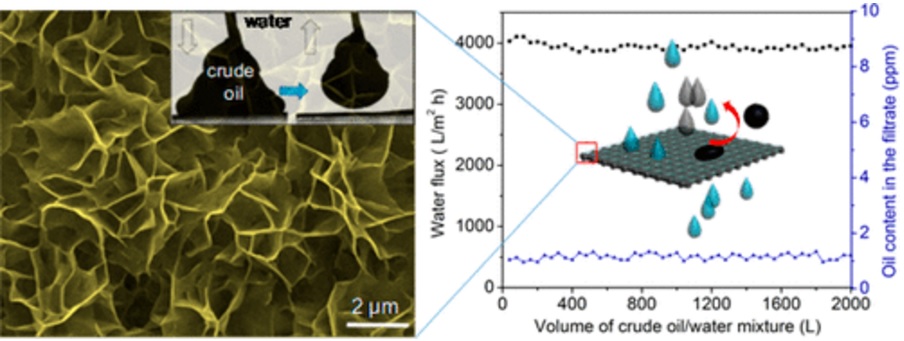
Nowadays separating oil from oily water is increasingly urgent because processes of oil extraction generate large volumes of complicated oily wastewater. An effective bioinspired method for separating oil/water mixture is to design superhydrophilic/underwater superoleophobic membranes based on the combination of high-surface-energy material and surface roughness.
Membranes made up of organic materials face a series of problems such as poor mechanical strength, weak environmental adaptability and stability, which restrict their use for practical application. As a result, inorganic membranes attract considerable attention, but there are few examples of fabricating all inorganic membranes with antioil-adhesion property for efficient crude oil/water separation.
The research group led by Prof. JIN Jian at Suzhou Institute of Nano-tech and Nano-Bionics of Chinese Academy of Sciences managed to fabricate a new type of inorganic mesh membrane made up of cupric phosphate (Cu3(PO4)2) for efficient oil/water separation. The study published in ACS Nano.
The researchers developed a completely inorganic mesh membrane made up of Cu3(PO4)2 in a special intersected nanosheets-constructed structure. Due to the combination of hierarchical structure of nanosheets with the strong hydration ability of Cu3(PO4)2 material, the mesh membrane exhibited a superhydrophilic and underwater superoleophobic property, especially a superior underwater anticrude-oil-fouling and antibio-fouling property. It showed excellent separation performance for treating oily water with large handling capacity and long-term stability.
Moreover, the all inorganic mesh membrane simultaneously exhibited high thermal stability up to 300 °C, good chemical stability, and a wide range of salt tolerance.
This is by far one of the best superwetting inorganic membranes for oil/water separation with separation performance. It shows potential for purifying real oily wastewater produced in industry and daily life and for treating high-viscosity oil polluted water.
This work was supported by the National Natural Science Funds for Distinguished Young Scholar, the Key Project of National Natural Science Foundation of China, the National Natural Science Foundation of China and the Natural Science Foundation of Jiangsu Province.

Illustration of cupric phosphate inorganic mesh membranes and the oil/water separation process. (Image by ZHANG Shenxiang)

86-10-68597521 (day)
86-10-68597289 (night)

52 Sanlihe Rd., Xicheng District,
Beijing, China (100864)

